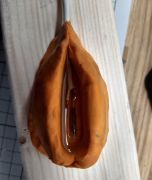|
Dance Officer posted:It was an aluminium block that had one side facemilled to decent surface roughness (0.4 Ra or so), all the other sides were roughly sawed. I only needed 3 sides square in relation to each other. That's how they taught me to make square things in machinists school. Nailed it.
|
|
|
|

|
| # ? May 26, 2024 18:45 |
|
I was taught that for a fully saw-cut part. You place it on a dowel and clamp the vice, face a side, then rotate that side to the solid jaw and do the next side. When the first face is down switch to parallels, then finish it up. For the ends you hang it out of the vice and side-mill, or switch to an angle iron with side-stop, use a dowel between the saw cut end and the table, while milled sides are against the angle iron, clamp it up in both directions and mill one end, then swap back to the vice for the last side. Routinely got me within 0.0005" of flat on mold bases in the 2 foot by 2 foot range using only angle-irons, and mold inserts around in a vice 6" were basically flat. Then you grind them.
|
|
|
|
Rutibex posted:That's how they taught me to make square things in machinists school. Nailed it. How they "taught" (explained it but never asked me to do it) it to me in school was to use regular jaws and skip the wire/round bar. I tried that way at first and the results weren't spectacular.
|
|
|
|
Dance Officer posted:How they "taught" (explained it but never asked me to do it) it to me in school was to use regular jaws and skip the wire/round bar. I tried that way at first and the results weren't spectacular. Yea the round piece is the magic ingredient. I use a 3/8 metal dowel.
|
|
|
|
I had to use a side mill for the first time this week, on stainless. Tool catalogue recommended Vc 55 m/min, f 1.3 mm/rev. It... did not sound good. At all. Ended up running it at Vc 25, f 0.03. Is it a thing with side mills that they sound like absolute poo poo?
|
|
|
|
Stainless can suck. Depends on the type. What size em and flute length?
|
|
|
|
And what stainless? 303 machines pretty well, 316 can be a bitch.
|
|
|
|
The side mill in question is 63x2 mm, this one: https://www.hoffmann-group.com/GB/e...00-63X2?tId=444 The material is X5 CrNiMo 17-12-2
|
|
|
|
yikes that is thin, what's the application, slotting? the only time I've run a carbide saw like that was in factory production on like 40mm x1.4 in one of 12 swiss lathe stations, I'll ask the tech tomorrow what the feed &speed are they still run that part but it's a high allow surface hardening steel, not stainless. gently caress stainless. It was a crazy application we used it for though, like slotting into only one side of a 14mm OD x 3mm wall tube, and the depth of that slot was the most critical dimension on the entire part, like -0 +50um shame on an IGA fucked around with this message at 02:55 on Jan 11, 2023 |
|
|
|
It's for slotting a 10mm deep slot in the middle of a product that's 6mm high and starts at 11mm wide, but goes back to 5mm wide about 5mm in. Also funny that you mention +0/50um, because that's the tolerance I'm trying to hit.
|
|
|
|
Dance Officer posted:The side mill in question is 63x2 mm, this one: Ohh gotcha, my brain did not parse side mill into that. It is a thing with them that finding their happy parameters is always going to be some trial and error.
|
|
|
|
Dance Officer posted:The side mill in question is 63x2 mm, this one: Effectively similar to the US's 316. That's gonna be tough, you're going to have to really play with the parameters. It work hardens wicked bad, doesn't transmit heat well, and galls like crazy. The fact that it's a slitting saw makes it even harder because your material engagement changes so much between the start of the cut and the middle. Machine rigidity is going to matter a lot, too. I wish you luck!
|
|
|
|
I am getting started with backyard metal casting, mostly with aluminum. I have a probably bad idea that I wanted to see if it’s possible. I am planning on casting a green lantern ring for my brother for his birthday as a display piece(in joke between the two of us) and to get the ring the emerald green it should be I was planning to anodize it and dye the ring as part of that process. The issue is that I’m not finding a way to polish the anodized piece after anodization. Is there a way to polish aluminum after anodizing and if not could I polish it before anodizing and have it keep the gloss?
|
|
|
|
My understanding is that the starting surface will remain essentially unchanged during anodization. So, get it looking exactly how you want beforehand, and then you should be good. Polishing afterwords will gently caress up the finish. Someone correct me if wrong, I am a few months away from trying this for the first time
|
|
|
|
that's my understanding too. anodization is extremely thin, like tens of microns, so any sort of polishing will remove it. but it also is extremely thin so it will pick up the underlying surface just fine.
|
|
|
|
ante posted:My understanding is that the starting surface will remain essentially unchanged during anodization. So, get it looking exactly how you want beforehand, and then you should be good. Sagebrush posted:that's my understanding too. anodization is extremely thin, like tens of microns, so any sort of polishing will remove it. but it also is extremely thin so it will pick up the underlying surface just fine. Ok, cool. Polish before anodizing, I can do that. Thanks!
|
|
|
|
Sagebrush posted:that's my understanding too. anodization is extremely thin, like tens of microns, so any sort of polishing will remove it. but it also is extremely thin so it will pick up the underlying surface just fine. It depends. TypeIII is more like a few thousandths. But yeah, any surface finish changes need to be done first.
|
|
|
|
My shop has to ship parts for anodising regularly. Typically, the customer requests a 18um layer thickness. Whatever the surface finish was before the anodising will show through and determine how it looks, so make sure it's good and shiny before handing it over to the anodising shop if you want it to come out good and shiny.
|
|
|
|
Dance Officer posted:My shop has to ship parts for anodising regularly. Typically, the customer requests a 18um layer thickness. Caveat to this is that if you sandblast, type II anodizing will show any fingerprints like crazy but also make the surface look much nicer. 100% polish before ano though.
|
|
|
|
my new apartment has one of those glass stovetops and it is making me acutely aware of the unflatness of the bottom of my cast iron skillet. should i surface it with a fly cutter y/n
|
|
|
|
Sagebrush posted:my new apartment has one of those glass stovetops and it is making me acutely aware of the unflatness of the bottom of my cast iron skillet. should i surface it with a fly cutter y/n Honestly I don't think it's a terrible idea.
|
|
|
|
Fly cutting cast works fine. Idk about doing it to a pan though.
|
|
|
|
Sagebrush posted:my new apartment has one of those glass stovetops and it is making me acutely aware of the unflatness of the bottom of my cast iron skillet. should i surface it with a fly cutter y/n These are better than they have any business being for the low low price: https://www.consumerreports.org/products/cookware-29545/nonstick-cookware-sets-29546/member-s-mark-sam-s-club-hard-anodized-aluminum-404518/ I dont chuck up things I can buy for like $20/ea. EDIT: The first rule of machining is "don't make nothin you can buy". CarForumPoster fucked around with this message at 02:17 on Jan 14, 2023 |
|
|
CarForumPoster posted:EDIT: The first rule of machining is "don't make nothin you can buy". Amen to that! I watched a dude spend like 3 days lovingly crafting an electrical box for a machine I was wiring. "But I can buy it for $87...", "Yes, but we're already paying him to be here."
|
|
|
|
|
Sagebrush posted:my new apartment has one of those glass stovetops and it is making me acutely aware of the unflatness of the bottom of my cast iron skillet. should i surface it with a fly cutter y/n in what way is it unflat? In addition to what the other folks are saying, if there's just one high spot you can go after it with an angle grinder (with a flap disk) or something and take that off and now it's flat enough. Leperflesh fucked around with this message at 02:57 on Jan 14, 2023 |
|
|
|
Sagebrush posted:my new apartment has one of those glass stovetops and it is making me acutely aware of the unflatness of the bottom of my cast iron skillet. should i surface it with a fly cutter y/n I've thought about doing this in the past, but I'd worry about accidentally thinning it to a wafer in 2-3 spots
|
|
|
|
Sagebrush posted:my new apartment has one of those glass stovetops and it is making me acutely aware of the unflatness of the bottom of my cast iron skillet. should i surface it with a fly cutter y/n Grab it in a four jaw and face it that way, if you can clear the handle swing?
|
|
|
|
my big skillet would require a ginormous lathe and I don't think it would chuck up easily even if the four jaw was big enough. I'd sooner give the mill a try. Glass stovetops suck unless they're induction but those don't care too much about flatness for nice heat transfer. Last week I did some antique bike frame surgery and torch bent some 25x2mm steel tube and it struck me again that I really need to get one of those many-flamed non-focused tips for general oxy/acetylene heating ("rosebud" maybe?, they're called "shower tips" in the local lingo) but they're rare as hen's teeth and cost a hundo new and never show up on the normal used stuff places where I can easily get a box full of welding tips for a few tenners. Anyway when I was done with the frame stripping and repairs I coated it in POR-15 (which I had to order from the one vendor in country that sells it) and I really liked how it came out, almost seemed powder coated after three applications. Then I proceeded with a generic slow drying metal enamel paint as topcoat for UV protection that made the frame look like poo poo again but at least it's not cracked or rusty anymore. Time will tell how well it lasts.
|
|
|
|
Hi thread, skipping ahead from page 113 (thanks whoever rec’d the blondihacks yt channel) I recently came into possession of an optical dividing head that’s in mostly amazing shape except one of the microscope viewing prisms is fouled and looks epoxied into place somehow because removing the set screw still doesn’t move the prism one bit. Since this is beyond my immediate ability to repair and I am not familiar with who would even have the ability to fix this (microscope repair shops?) I turn to the collective knowledge of the forums and hope someone else here is fascinated by old poo poo like I am. Alternatively, if there’s a place to go and scour for parts for machines like these, I’m not above paying for a replacement or complete remanufacturing of the little bit. It’s a Leitz model and I’ve already sent Leica microsystems an email since it looks like the appropriate business segment, but I’d be amazed if they got back to me.
|
|
|
|
My job has me tapping an internal thread on a 304 stainless tube. The wall thickness is oversized, so that will allow me to drill it to the correct size for tapping. The tap is M6 .5mm pitch. I need to know what size pilot hole to drill, but all the tap charts I'm seeing only show M6x1mm and M6x.75mm. Any idea what drill I should use. I have fractional, metric, numbered, and lettered drills. Thanks!
|
|
|
|
SkunkDuster posted:My job has me tapping an internal thread on a 304 stainless tube. The wall thickness is oversized, so that will allow me to drill it to the correct size for tapping. The tap is M6 .5mm pitch. I need to know what size pilot hole to drill, but all the tap charts I'm seeing only show M6x1mm and M6x.75mm. Any idea what drill I should use. I have fractional, metric, numbered, and lettered drills. Thanks! https://www.machiningdoctor.com/calculators/threading/ check what fit class it has to be but 5.4-5.5 should have you in the ballpark maybe experiment on some scrap material if you want it perfect shame on an IGA fucked around with this message at 16:38 on Jan 16, 2023 |
|
|
|
shame on an IGA posted:https://www.machiningdoctor.com/calculators/threading/ Thanks for the quick reply! I don't think I will be able to find out the fit class as we're trying to fit a part from one manufacturer onto a part from a different manufacturer. Imagine installing an arrowhead from AAA onto a shaft from BBB. Luckily, the tube is much longer than we need, so if it doesn't work out, I can just part it off and try again.
|
|
|
|
All the taps that we use in the shop have what size drill to use lasered on to them, I'm surprised that's not universal.
|
|
|
|
Dance Officer posted:All the taps that we use in the shop have what size drill to use lasered on to them, I'm surprised that's not universal. what brand are those because I'm buying them
|
|
|
|
Hoffmann Group, I don't think they're active in the US or Canada though.
|
|
|
|
oh they are and it's about that time of year for them to flood our receiving department with unsolicited hardcover catalogs again
|
|
|
|
Sagebrush posted:my new apartment has one of those glass stovetops and it is making me acutely aware of the unflatness of the bottom of my cast iron skillet. should i surface it with a fly cutter y/n Will you put these up for sale please on SA mart, I'll buy at least two
|
|
|
|
SkunkDuster posted:My job has me tapping an internal thread on a 304 stainless tube. The wall thickness is oversized, so that will allow me to drill it to the correct size for tapping. The tap is M6 .5mm pitch. I need to know what size pilot hole to drill, but all the tap charts I'm seeing only show M6x1mm and M6x.75mm. Any idea what drill I should use. I have fractional, metric, numbered, and lettered drills. Thanks! Metric threads make figuring out the drill size very easy. Simply subtract the thread pitch from the thread major and you have it. For instance: M5 x 0.8 -> 5.0-0.8=4.2mm M8-1.25=6.75mm (but we use the 6.8mm in the shop) Etc etc. So in your case, the M6x.5 would take a 5.5mm drill. This works on imperial sizes too, but the thread spec is labeled as the inverse (threads per inch, rather than pitch, that is: inches per thread) and the major diameter isn’t marked under the 1/4” sizes. So if you want to know what to drill a 4-40 thread, you look up the #4 size and see it’s major is 0.112”, you take the inverse of 40threads/inch: 1”/40= 0.025”, and then you subtract the pitch from the major: 0.114”-0.025” = 0.089”drill (which is the trusty #43 drill) This method is for cut taps and basically gives you a 75% thread which is good for Aluminum and plastics (we do shitloads of delrin at work). If I’m doing stainless I’ll usually size up one drill size. For forming/roll taps there is a whole other calculation but the real method is: “look it up in the chart”
|
|
|
|
tylertfb posted:Metric threads make figuring out the drill size very easy. Simply subtract the thread pitch from the thread major and you have it. For instance: M5 x 0.8 -> 5.0-0.8=4.2mm That is incredibly useful to know. Thanks!
|
|
|
|

|
| # ? May 26, 2024 18:45 |
|
It's a good rule of thumb, but not always true. If you predrill an M2 roll tap with a 1.7mm drill like the rule says you should, it's going to cost you your tap.
Dance Officer fucked around with this message at 02:44 on Jan 18, 2023 |
|
|































